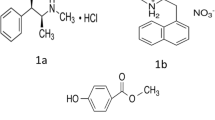Abstract
Drug abuse is a global menace in the society. Strict measures are planned and effectuated to dismantle this crime yet a large number of cases of narcotics drugs are seized and referred to forensic science laboratories for analysis. Over the past few years, the misuse of precursor chemicals has increased substantially. Examination of these precursor chemicals, especially ephedrine and its analogues, is a major task for forensic analysts. Though gas chromatography–mass spectrometry (GC–MS) is a well-established technique, it dwindles in the identification of the analogues of ephedrine as they have similarity in molecular weight and structure. The analysis involves time-consuming extraction and derivatization process in sample preparation when used for the identification of isomers. The present paper describes a use of high-performance thin-layer chromatography coupled with mass spectrometry (HPTLC–MS) for the purpose. This technique requires minimum sample preparation; it is a quick and easy methodology with no derivatization and gives a conclusive result for the separation and identification of ephedrine analogues. The drug samples were dissolved in methanol and spotted on Si60 F254 thin-layer chromatography (TLC) plate. Good separation of ephedrine from a mixture of ephedrine, pseudoephedrine, and phenylpropanolamine was achieved using the solvent system n-butyl acetate–acetone–n-butanol–5 M ammonia–methanol (4:2:2:1:1, v/v). The separated spot on the TLC was subjected to MS, which identified ephedrine with confirmation.








Similar content being viewed by others
Data availability
The work has been carried out on left over forensic seized samples.
References
Bell DS, Cramer HM, Jones DA (2005) Rational method development strategies on fluorinated liquid chromatography stationary phase: mobile phase ion concentration and temperature effects on the separation of ephedrine alkaloids. J Chromatogr A 1095:113–118
Wong CH, Ho EN, Kwok WH, Leung DK, Leung GN, Tang FP, Wong AS, Wong JK, Yu NH, Wan TS (2012) Interconversion of ephedrine and pseudoephedrine during chemical derivatization. Drug Test Anal 4:1028–1033
Moffat AC, Osselton MD, Widdop B (2011) Clarke’s analysis of drugs and poisons, 4th edn. Pharmaceutical Press, London
Houck MM, Siegel JA (2015) Chapter 13, Illicit Drugs. In: Fundamentals of forensic science, 3rd edn. Elsevier, Amsterdam, pp 315–352
King LA, Meer APD (2001) New synthetic drugs in the European Union. Sci Justice 8:200–202
Papoutsis II, Athanaselis SA, Nikolaou PD, Pistos CM, Spiliopoulou CA, Maravelias CP (2010) Development and validation of an EI–GC–MS method for the determination of benzodiazepine drugs and their metabolites in blood: applications in clinical and forensic toxicology. J Pharm Biomed Anal 52:609–614
Srivastava M (2011) High-performance thin-layer chromatography (HPTLC). Springer Verlag, Berlin
UNODC (2006) Recommended methods for the identification and analysis of amphetamine, methamphetamine and their ring substituted analogues in seized materials. United Nations Office on Drugs and Crime, Vienna
Wang SM, Lewis RJ, Canfield D, Lia TL, Liu RH (2005) Enantiomeric analysis of ephedrines and norephedrines. DOT/FAA/AM-05/8, 14
Ministry of Health and Family Welfare (1996, 2014) Indian pharmacopoeia. Government of India, Delhi
Zuba D (2007) Medicines containing ephedrine and pseudoephedrine as a source of methcathinone. NCJRS, National Criminal Justice Reference Service, Rockville, MD
Code availability
Not applicable.
Adherence to national and international regulations
Yes
Author information
Authors and Affiliations
Contributions
1 K. Goyal – study conception and design, acquisition of data, interpretation of data.
2 N. Tomar – drafting of manuscript, interpretation of data.
3 A. P. Singh – analysis of data.
4 R. K. Sarin – critical revision of manuscript.
5 S. K. Shukla – critical revision of manuscript.
Corresponding author
Ethics declarations
Competing interests
The authors declare that they have no competing interests.
Ethical approval
Not applicable.
Consent for publication
Not applicable.
Rights and permissions
About this article
Cite this article
Goyal, K., Tomar, N., Singh, A.P. et al. Validation of an analytical method for the detection of ephedrine and its analogues in forensic samples using HPTLC–MS. JPC-J Planar Chromat 33, 397–404 (2020). https://doi.org/10.1007/s00764-020-00049-6
Received:
Accepted:
Published:
Issue Date:
DOI: https://doi.org/10.1007/s00764-020-00049-6




